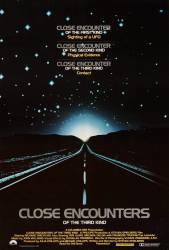Continuity mistake: While the first UFO is blinding Roy, he protects his face. The distance between his hand and his face, and the expression on his face, keep swapping back and forth depending on the angle.
Continuity mistake: When Roy leans towards the steering wheel to watch the UFO, the position of his hands over the wheel changes between shots.
Continuity mistake: The mashed potato that Roy serves himself swaps from stiff to creamy between one shot and the other.






Chosen answer: I own the original (not special edition) DVD and I can always freeze the film and point out to people where the alien is and they see it too, but I can never see it when it's on TV or on my friends VHS copy, maybe it's just a 'gift' for the DVD owners?